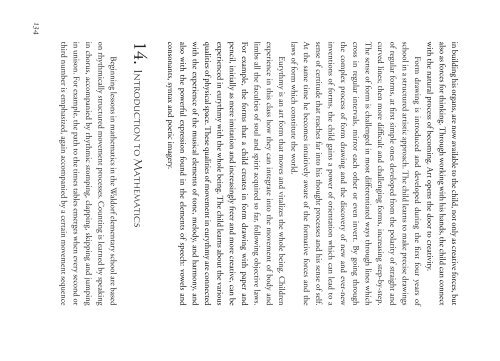Developmental Signatures - Waldorf Research Institute
Developmental Signatures - Waldorf Research Institute
Developmental Signatures - Waldorf Research Institute
Create successful ePaper yourself
Turn your PDF publications into a flip-book with our unique Google optimized e-Paper software.
in building his organs, are now available to the child, not only as creative forces, but<br />
also as forces for thinking. Through working with his hands, the child can connect<br />
with the natural process of becoming. Art opens the door to creativity.<br />
Form drawing is introduced and developed during the first four years of<br />
school in a structured artistic approach. The child learns to make precise drawings<br />
of regular forms, at first simple ones developed from the polarity of straight and<br />
curved lines; then more difficult and challenging forms, increasing step-by-step.<br />
The sense of form is challenged in most differentiated ways through lines which<br />
cross in regular intervals, mirror each other or even invert. By going through<br />
the complex process of form drawing and the discovery of new and ever-new<br />
inventions of forms, the child gains a power of orientation which can lead to a<br />
sense of certitude that reaches far into his thought processes and his sense of self.<br />
At the same time he becomes intuitively aware of the formative forces and the<br />
laws of form which constitute the world.<br />
Eurythmy is an art form that moves and vitalizes the whole being. Children<br />
experience in this class how they can integrate into the movement of body and<br />
limbs all the faculties of soul and spirit acquired so far, following objective laws.<br />
For example, the forms that a child creates in form drawing with paper and<br />
pencil, initially as mere imitation and increasingly freer and more creative, can be<br />
experienced in eurythmy with the whole being. The child learns about the various<br />
qualities of physical space. These qualities of movement in eurythmy are connected<br />
with the experience of the musical elements of tone, melody, and harmony, and<br />
also with the powerful expression found in the elements of speech: vowels and<br />
consonants, syntax and poetic imagery.<br />
14. <br />
Beginning lessons in mathematics in the <strong>Waldorf</strong> elementary school are based<br />
on rhythmically structured movement processes. Counting is learned by speaking<br />
in chorus, accompanied by rhythmic stomping, clapping, skipping and jumping<br />
in unison. For example, the path to the times tables emerges when every second or<br />
third number is emphasized, again accompanied by a certain movement sequence
















